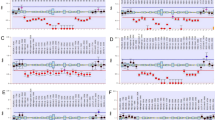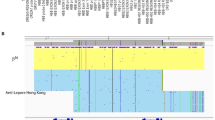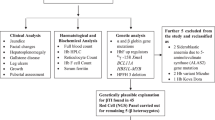Abstract
IN most human populations, the α-globin structural gene loci are duplicated so that each diploid cell contains four copies of α-globin genes1–3. In α-thalassaemia, a hereditary disorder of α-globin chain synthesis, the most common molecular lesion is due to the deletion of the α-globin genes4–7. In the Asian population, four main α-thalassaemia syndromes of increasing clinical severity are recognised: (1) the silent carrier state (α-thalassaemia-2) with no clinical manifestation; (2) α-thalassaemia trait (α-thalassaemia-1), characterised by microcytic red blood cells but little or no anaemia; (3) haemoglobin-H disease, which manifests as haemolytic anaemia; and (4) homozygous α-thalassaemia, in which the afflicted fetus dies at or around term from hydrops fetalis. These four syndromes are due to the deletion of from one to all four copies of the α-globin genes. In this study, we have characterised α-thalassaemia in people of African origin. Haemoglobin screening programmes have shown that α-thalassaemia occurs in the black population8–10. Recently we have demonstrated by complementary DNA–DNA hybridisation that in black individuals with clinically well defined α-thalassaemia trait, two of the four normal α-globin genes were deleted11. However, in this population, haemoglobin-H disease is rare and homozygous α-thalassaemia has never been found12,13. For this study we have used the restriction endonuclease mapping technique of Southern14 to delineate the nature of the deletion of the α-globin genes.
This is a preview of subscription content, access via your institution
Access options
Subscribe to this journal
Receive 51 print issues and online access
$199.00 per year
only $3.90 per issue
Buy this article
- Purchase on Springer Link
- Instant access to full article PDF
Prices may be subject to local taxes which are calculated during checkout
Similar content being viewed by others
References
Lehmann, H. & Carrell, R. W. Br. med. J. 4, 748–750 (1968).
Hollan, S. R. et al. Nature 235, 47–50 (1972).
Lie-Injo, L. E., Ganesan, J., Clegg, J. B. & Weatherall, D. J. Blood 43, 251–259 (1974).
Ottolenghi, S. et al. Nature 251, 389–392 (1974).
Taylor, J. M. et al. Nature 251, 392–393 (1974).
Kan, Y. W. et al. Nature 255, 255–256 (1975).
Ramirez, F. et al. Proc. natn. Acad. Sci. U.S.A. 72, 1550–1554 (1975).
Schwartz, E. & Atwater, J. J. clin. Invest. 51, 412–418 (1972).
Altay, C. et al. Pediat. Res. 11, 147–152 (1977).
Pierce, H. I., Karachi, S., Sofroniadou, K. & Stamatoyannopoulos, G. Blood 49, 981–986 (1977).
Davis, J. R. Jr, et al. Am. J. hum. Genet. (in the press).
Esan, G. J. F. Br. J. Haemat. 19, 47–56 (1970).
Stamatoyannopoulos, G., Haywood, D. & Papayannopoulou, T. Birth Defects Original Article Series 8m, 29–38 (1972).
Southern, E. M. J. molec. Biol. 98, 503–517 (1975).
Orkin, S. H. et al. Cell 17, 33–42 (1979).
Embury, S. H., Lebo, R. V., Dozy, A. M. & Kan, Y. W. J. clin. Invest. 63, 1307–1310 (1979).
Kan, Y. W. & Dozy, A. M. Proc. natn. Acad. Sci. U.S.A. 75, 5631–5635 (1978).
Wilson, J. T. et al. Nucleic Acids Res. 5, 563–581 (1978).
Maniatis, T., Jeffrey, A. & Kleid, D. G. Proc. natn. Acad. Sci. U.S.A. 72, 1184–1188 (1975).
Lehmann, H. Lancet ii, 78–80 (1970).
Brittenham, G. Nature 268, 635–636 (1977).
Author information
Authors and Affiliations
Rights and permissions
About this article
Cite this article
DOZY, A., KAN, Y., EMBURY, S. et al. α-Globin gene organisation in blacks precludes the severe form of α-thalassaemia. Nature 280, 605–607 (1979). https://doi.org/10.1038/280605a0
Received:
Accepted:
Published:
Issue Date:
DOI: https://doi.org/10.1038/280605a0
This article is cited by
-
Erythropoietin for hemoglobin H disease
Annals of Hematology (2009)
-
Fetal hemoglobin in sickle cell anemia: genetic determinants of response to hydroxyurea
The Pharmacogenomics Journal (2007)
-
There are two C4 genetic loci and a null allele in the chimpanzee
Immunogenetics (1987)
-
Alpha thalassaemia in an Irish family — a previously unreported finding
Irish Journal of Medical Science (1985)
-
?-Thalassemia among sickle cell anemia patients in various African populations
Human Genetics (1984)
Comments
By submitting a comment you agree to abide by our Terms and Community Guidelines. If you find something abusive or that does not comply with our terms or guidelines please flag it as inappropriate.



